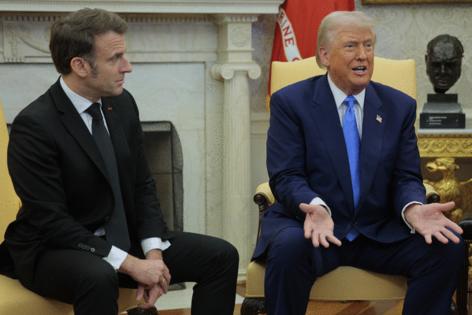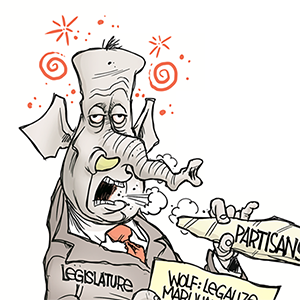Trump says planned tariffs on Canada, Mexico 'going forward'
Published in News & Features
WASHINGTON — President Donald Trump said tariffs scheduled to hit Canada and Mexico next month were “on time” and “moving along very rapidly” following an initial delay, even as a U.S. official cautioned the schedule could be less certain.
Trump was asked if the tariffs, which he delayed until March 4, would go into effect next week as he fielded questions during a joint press conference with French President Emmanuel Macron. Canada and Mexico have implemented new border measures in an effort to stave off the tariffs, which Trump says he is levying in a bid to halt flows of undocumented migrants and illegal drugs such as fentanyl.
“The tariffs are going forward on time, on schedule,” Trump responded.
But following the remarks, a U.S. official, who spoke on the condition of anonymity, said the fate of the special 25% levy on Canada and Mexico — tied to border security demands — was still to be determined. Trump’s so-called reciprocal tariffs that could hit all countries, including Canada and Mexico, will go forward in April, the official said.
Trump did pivot later in his response to discuss his plan to impose those tariffs. The Commerce Department is currently calculating the rate it will impose on other countries, promising to incorporate both tariffs and other barriers on U.S. imports.
“We want to have the same — so if somebody charges us, we charge them. It’s very simple,” Trump said. “But it’ll be very good for our country. Our country will be extremely liquid and rich again.”
Trump has moved quickly to announce sweeping tariffs in his second-term, part of an agenda that aims to use the levies to reshape what he says is a global trading system that is unfairly tilted against the U.S., and to convince businesses to create more domestic manufacturing jobs.
The U.S. president has already put in place a 10% tariff rate on imports from China, and tariffs on steel and aluminum are slated to take effect in March. The reciprocal levies Trump has pledged could come as soon as April, but those will require the U.S. to calculate those rates on a country-by-country basis. Trump has also said he would likely impose tariffs on automobile, lumber, semiconductor and pharmaceutical imports of around 25%, with an announcement on those coming as soon as April 2.
Trump has touted his tariff measures as spurring new investments in the U.S. and as a critical source of revenue as congressional lawmakers work to secure passage of legislation renewing and extending tax cuts. But mainstream economists warn the levies threaten to exacerbate price growth — an issue that helped propel Trump to the White House in last year’s election — and caution that tariffs will not bring in the revenue the president and his allies project.
The tariffs against Canada and Mexico would hit U.S. neighbors and major trading partners, threatening to rattle continent-wide supply chains and impacting key industries such as the auto sector as well as energy. Parts of the U.S., including the Pacific Northwest and Northeast U.S., are deeply reliant on electricity or gas flows from Canada. Trump’s tariffs would see Canadian energy products face a 10% duty.
Trump first threatened the tariffs during the presidential transition, accusing Canada and Mexico of not doing enough to secure U.S. borders, a top issue for him. Canada has moved to broaden its power to clamp down on drug cartels in a bid to assure Trump they are taking action. Canadian Prime Minister Justin Trudeau has also appointed a “fentanyl czar” to lead efforts to stop the flow of the drug across borders.
_____
(With assistance from Josh Wingrove.)
_____
©2025 Bloomberg L.P. Visit bloomberg.com. Distributed by Tribune Content Agency, LLC.







Comments